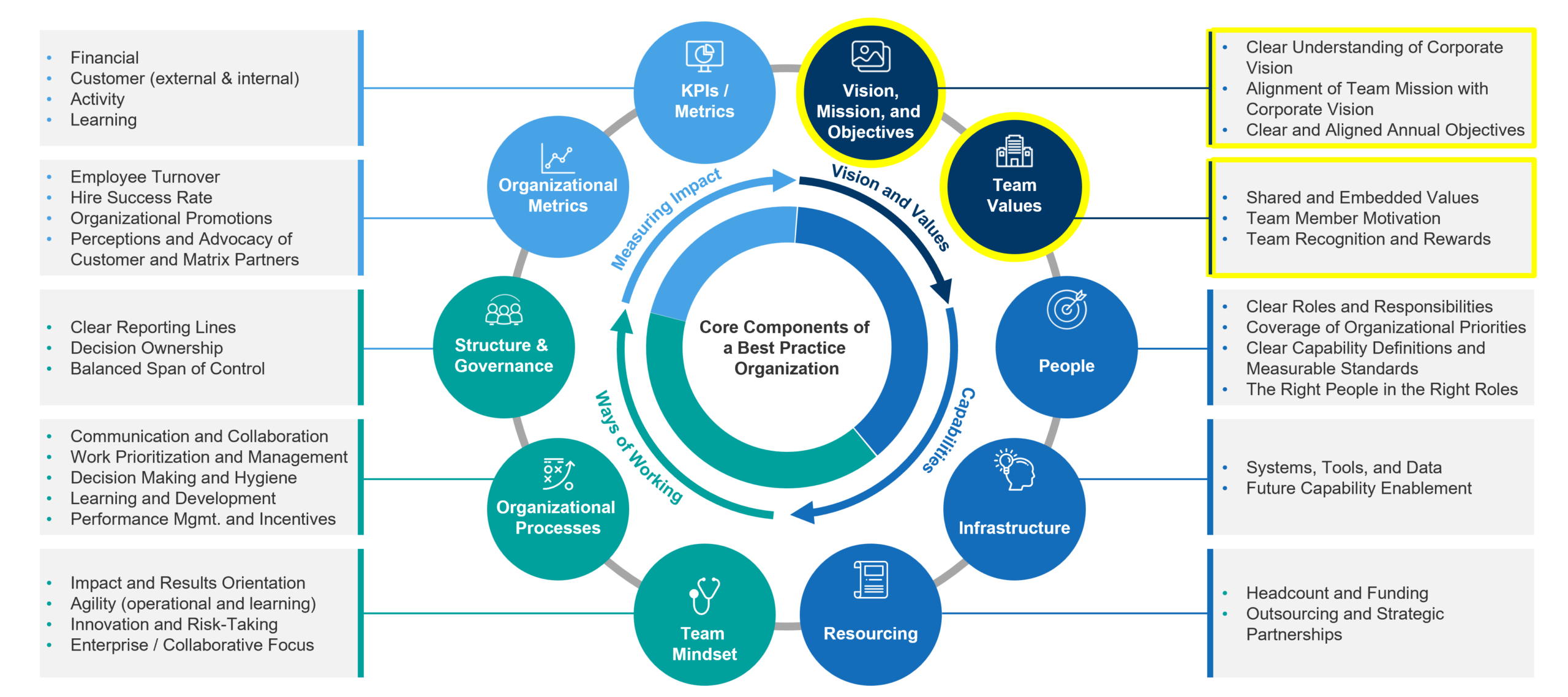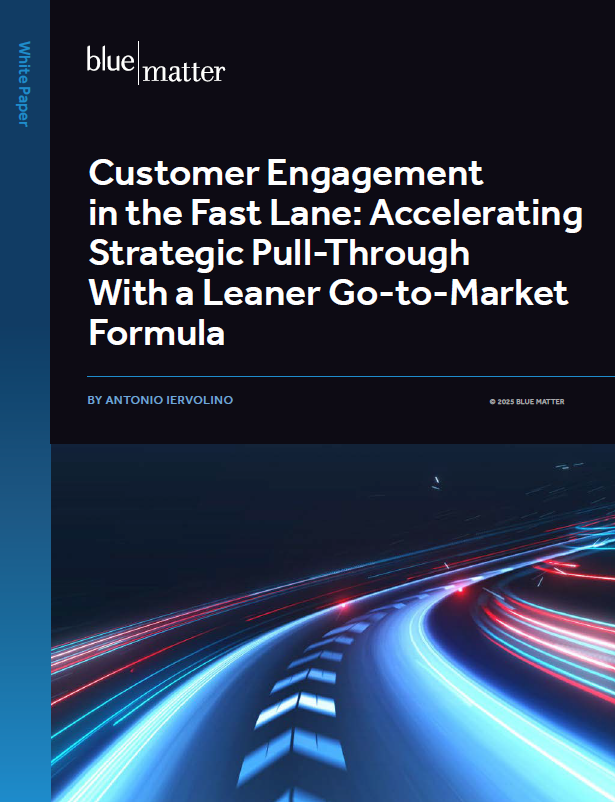
While adopting the qualities of what we call a “Best Practice Organization”—high performance, effectiveness, and efficiency—can benefit all companies, there’s no question that doing so is especially important for biopharmaceutical firms. This is because the biopharma industry exists in an environment of rapid change, with stringent regulatory oversight and vigorous competition. Any biopharma company that chooses to ignore these priorities risks being left behind.
As we discussed in part 1 of this series, four elements make up a Best Practice Organization (BPO):
- Vision, Mission, and Values
- Capabilities
- Ways of Working
- Measuring Impact
In this article, we take a deep dive into the first element, Vision, Mission, and Values. We go into depth about what those principles are, discuss why they’re important for biopharma companies, and share some examples of companies’ vision, mission, and values statements (both in and outside of biopharma). Subsequent articles in the weeks to come will explore the other topics.
Defining Vision and Its Importance
A company’s vision is an aspirational future end state that inspires the organization to action and offers high-level direction for that action. Ideally, organizations’ vision statements are fairly fixed, staying in place over time. The vision statements of BPOs are clear, unique, concise, and inspirational.
Some of the fundamental questions a vision may address include the following:
- What will our impact be?
- Who will we serve?
- What will we offer or accomplish?
- What is our identity and how do we want to be seen by others and ourselves?
Having a clear, well-communicated vision is critical to organizational success. A vision that inspires and motivates the team provides a “North Star” that team members can always orient themselves toward and align their priorities with. Simply put, a company that offers its employees a clear vision more effectively enables them to work in support of that company’s goals.
Sample Vision Statements:
| Organization | Vision |
|---|---|
| Johnson & Johnson | To help people see better, connect better, live better. |
| Organon | We envision a better and healthier every day for everyone, with a focus on supporting women’s health. |
| Alzheimer’s Association | A world without Alzheimer's and all other dementia®. |
| The Walt Disney Company | To be one of the world’s leading producers and providers of entertainment and information. |
Sources: J&J, Organon, Alzheimer’s Association, Disney
Why Mission Matters
When a company’s vision is translated into more concrete terms, it becomes a mission. A clear, detailed mission statement that points toward the organization’s vision is essential for defining a Best Practice Organization’s purpose, and it gives individuals specific direction on how to conduct their work on a day-to-day basis, both at the corporate and team levels.
An effective corporate mission statement may address some or all of the following questions:
- Who are we as an organization?
- What do we do?
- How do we do it?
- What outcome(s) are we looking to achieve?
While vision statements always apply to the entire organization, smaller units within a company may customize a corporate mission statement to meet their individual circumstances. The most effective groups within an organization—such as functional areas, business units, and cross-functional teams—adopt individual mission statements. These statements interpret the corporate mission for the team’s own unique situation while remaining aligned with the overall organizational mission.
Sample Mission Statements:
| Organization | Mission |
|---|---|
| Johnson & Johnson | To improve human health utilizing the Company’s excellence in pharmaceuticals, medical devices, and consumer products. |
| Organon | Our mission is to deliver impactful medicines and solutions for a healthier every day. |
| Alzheimer’s Association | The Alzheimer's Association leads the way to end Alzheimer's and all other dementia—by accelerating global research, driving risk reduction and early detection, and maximizing quality care and support. |
| The Walt Disney Company | The mission of The Walt Disney Company is to entertain, inform and inspire people around the globe through the power of unparalleled storytelling, reflecting the iconic brands, creative minds and innovative technologies that make ours the world’s premier entertainment company. |
Sources: J&J, Organon, Alzheimer’s Association, Disney
Understanding Values
Values are the principles that guide team members in their work and motivate them to make specific choices as they go about their jobs. The values of BPOs are most often memorable, actionable, and observable. We encourage leaders to mention them often and incorporate them into individuals’ performance reviews.
Ideally, companies should have between three and five values that remain constant over time. When they do change, it should be for important reasons only, such as a significant update to corporate identity or strategy.
A strong set of values helps companies accomplish their goals. They support the culture that leaders aim to build. For example, a company whose values speak to the traits they wish to see in their employees allows recruiters to prioritize those qualities in hiring. When organizations focus on actively living their values, they are more likely to take root and drive a positive culture; organizations that fail to do so run the risk of having unwelcome values and culture evolve on their own.
Sample Values Statements:
| Organization | Values |
|---|---|
| Johnson & Johnson | Responsibility to patients, doctors, and nurses; employees; the communities the company operates in; and stockholders. |
| Organon | Our employees take the promise of Organon and turn it into a reality, with a calling to help create what has been missing in the world. Above all, we act with integrity because we are the foundation for what the company will become and our values are how we get things done around here. |
| Alzheimer’s Association | Inclusivity, community, accountability, agility and integrity are the core values that define the Alzheimer's Association's culture and people. |
| The Walt Disney Company | Optimism, innovation, decency, quality, community, and storytelling. |
Sources: J&J, Organon, Alzheimer’s Association, Disney
How Vision, Mission, and Values Guide Actions
Some of the best-known and highest-functioning organizations in the world—both within and outside of the biopharma industry—are guided by clear vision, mission, and values that inform their actions. These actions translate both to the strategic level as well as to the tactical choices individual employees make in their day-to-day work, and they help the best-functioning companies operate at the highest possible level. The following are several examples of how high-performing organizations translate their vision, mission, and/or values into action.
- Johnson & Johnson: The clarity of Johnson & Johnson’s vision, mission, and values help the company align individual initiatives with corporate objectives. For example, after an unknown individual placed cyanide in Tylenol bottles on shelves in 1982, leading to the deaths of seven people, the company developed the first tamper-evident packaging—a mark of their commitment to patients, the community, and ultimately shareholders as well.
- Organon: Having vision, mission, and values that clearly articulate Organon’s goal of serving women guides the company to market more than 60 products specifically for that audience. This has helped the company succeed financially (for example, being named to Pharmaceutical Executive’s Top 50 Pharmaceutical Companies for 2023) while also accomplishing their social goals (such as being named to the 2023 Bloomberg Gender-Equality Index).
- Alzheimer’s Association: The simple clarity of the Alzheimer’s Association’s vision, mission, and values helps dictate the main pillars of their operations: care for patients, education and awareness, and research.
- The Walt Disney Company: Disney’s vision and mission both encompass the full range of their complex business, covering both entertainment (e.g., movies and theme parks) and information (e.g., networks such as ABC and ESPN), and its positive values are instantly recognizable to anybody familiar with the company’s products.
Of course, vision or values statements alone are not necessarily enough to help a company become a BPO. When Enron declared bankruptcy in 2001, it was one of the largest energy companies in the world, with more than $100 million in revenue the year before. The company’s Values statement at the time of its collapse was “Integrity, Communication, Respect, and Excellence.” While that may seem like an admirable set of values, they masked a company that was later discovered to have been inflating profits and their share price by hiding liabilities from their balance sheet, and booking years’ worth of future revenues.
Similarly, the investment bank Bear Stearns, which collapsed during the 2008 financial crisis, had a values statement that read, “We believe that ethics must go beyond what the laws, regulations and rules of finance require.” Despite those stated values, the major driver of the company’s collapse was its heavy investment in financially risky and ethically dubious subprime mortgage funds.
While corporate vision and values are essential, they can become no more than platitudes in organizations that do not prioritize them and use them to guide their actions. In fact, as the examples from Enron and Bear Stearns demonstrate, companies that do not emphasize their vision, mission, and values as part of their operations risk allowing more negative and risky behaviors to take root. In order to operate as a Best Practice Organization—like Johnson & Johnson, Organon, and many others—companies must actively build and encourage the vision, mission, and values they claim to espouse.
Coming Next
Now that we’ve defined a Best Practice Organization and looked in detail at how Vision, Mission, and Values can help BPOs accomplish their goals, the next article in the series will look more deeply at Capabilities: how team members, processes, systems, tools, and data come together to help companies meet their needs, as well as those of patients and customers. These elements can determine whether an organization will stand out in its industry or be left behind by the competition.








